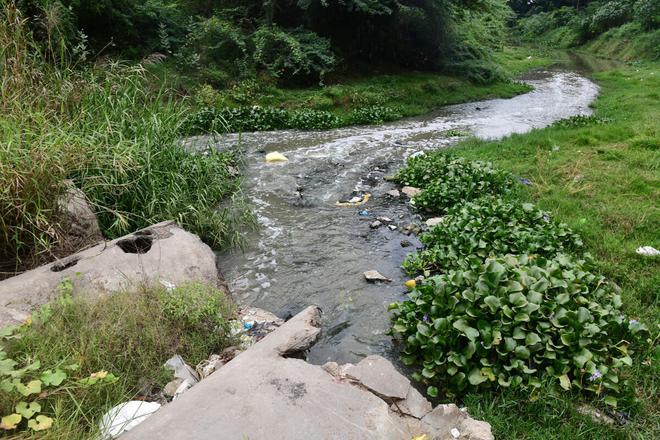
What happens when Nature takes on grey hues? “A pall of gloom descends, a sign of bad tidings,” says G. Chandrasekaran, a retired art teacher, as he describes a painting on River Noyyal. Mr. Chandrasekaran, with 30 fine arts students, had a decade ago followed the trail of the Noyyal, a 167-km glorious journey from Kooduthurai near Alandurai in Siruvani all the way to the Cauvery near Karur, and made on-the-spot sketches of what they saw.
“The work by one of my students captured the landscape, the tree, and flowers in grey streaks, indicating the disaster waiting to unfold on the environment. Though it was done a decade ago, it holds true even today,” says Mr. Chandrasekaran, who headed the Department of the Government College of Fine Arts, Chennai. “The objective was to use art as a tool to create social awareness of the importance of conserving natural resources, and water gets the priority,” he says.
A garland of lakes
Coimbatore is known for its many lakes. Historians often describe the city as a beautiful woman adorned with a garland of navaratnams, represented by the lakes of River Noyyal at Narasampathy, Krishnampathy, Selvampathy, Puttuvikki, Selvachintamanikulam, Puliakulam (now a town), Vaalankulam, and Kurichikulam to name a few.
With the last Tamil Nadu Budget announcing plans for revival of the Noyyal, environmentalists and artists hold out a gleam of hope even as the river struggles to survive in the face of development.
“A vivid childhood memory is fishing using a wet rag in pristine waters of the river,” says K. Mohanraj, 53, an environmental activist, who has mapped and documented the river basin over 15 years. Originating in the Vellingiri Hills of the Western Ghats as a small rivulet, the Noyyal finds a place in ancient Tamil literature. Through the centuries, the river has stood testimony to generations taking holy dips and conducting ceremonies on its banks. Hundreds of fishermen families and farming communities depend on its water for livelihood.
“While the first zone from the point of origin to the Perur Puttuvikki lake is still pollution-free and supports a thriving bio-diversity of aquatic life, migratory and resident birds, and butterflies, the second zone that stretches from the city limits to the Orathupalayam Dam near Tiruppur is choked with domestic and industrial wastes. The third zone from here is downhill and it is reduced to a gutter before it branches into Noyyal village near Karur,” he adds.
A growing concern
Encroachments along the river bank, infrastructure development, and dumping of waste along the channels that interlink the tanks are a growing concern. A collective effort of people and the government can go a long way in restoring the river’s glory. “A scientific approach is the key to reviving the river. It should go beyond building new check-dams or adding walkways and greenery. We need micro-sewage treatment plants,” says Mr. Mohanraj.
The old township of Coimbatore resembled an island with the Noyyal and its rivulets, channels and tanks enveloping the city and its periphery. “Civilisation, as old as 2000 years, flourished on the banks of the Noyyal,” says Perur V Jayaram, well-known for his interest in Coimbatore’s history. To drive home the point, he says archaeological teams have unearthed a 2,100-year-old Roman silver coin and 1,700-year-old copper coins at Vellalore, once part of an ancient trade route for Roman traders. This indicated a healthy civilisation and a thriving trade that once flourished along the banks of the river.
Engineering wonder
Calling the Noyyal tank canal system an engineering wonder, he says a garland of 30 lakes and anaicuts along its course ensured that the entire surplus water of the Noyyal flowed through them without flooding the villages. These tanks also replenished the groundwater table. As the city grew, these tanks vanished from the landscape. Besides Noyyal, Coimbatore has the Sanganur stream that originates near Thadagam, and the Koushika near Periyanaickenpalayam.
R. Manikandan, founder of Kovai Kulangal Pathukappu Amaippu, which works towards reviving and restoring waterbodies in and around Coimbatore, believes in the power of collective action to bring about a change. “We have failed to save the river. We have to learn our lessons and make efforts to conserve our natural resources for the future. Farmers should keep a check on the use of groundwater. And, reconsider growing rain-fed crops, like millets, instead of water-intensive paddy, sugar cane and banana. This will help to recharge the groundwater table in a big way.”
Glorious days of Cholan Thurai
Mr. Jayaram remembers the glorious days of Cholan Thurai, a bathing bay near the Perur Pateeswarar Temple, constructed during the Chola period. “In my childhood, it was our beach. We played there on moonlit nights over the sand bed that stretched endlessly. Till Perur, the Noyyal water is still clean and pristine. There is hope,” he concludes.







